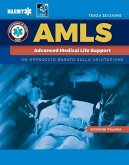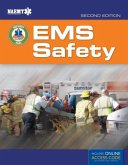This bundle comes with two resources.Geriatric Education for Emergency Medical Services, Third EditionAccording to the Centers for Disease Control and Prevention, Americans aged 65 and over comprise 15 percent of the population but account for nearly 40 percent of ambulance transports. This is not surprising given that older adults experience more chronic conditions, multiple diseases, and polypharmacy issues than the rest of the population. Yet despite EMS practitioners' experience in the field, research shows that geriatric trauma patients are often undertriaged to trauma centers. High-quality geriatric-specific education can make a difference. With the right text, EMS practitioners can gain a deeper understanding of how the body ages, how multiple medications can create or exacerbate emergencies, how certain communication techniques can improve assessments, and more. Armed with new knowledge, EMS professionals can learn how to give older patients in their community better emergency care and an improved quality of life.The third edition of Geriatric Education for Emergency Medical Services is authored by experts in the field, reviewed by the American Geriatrics Society (AGS), and endorsed by the National Association of Emergency Medical Technicians (NAEMT). Comprehensive and updated, the new edition addresses the National EMS Education Standards in 15 chapters--covering communication, assessment, trauma, respiratory and cardiovascular emergencies, medication toxicity, elder abuse, and much more.The third edition provides even greater value: - New guidance on how to conduct a comprehensive geriatric assessment- New education on how to correctly triage older patients and transport them to the appropriate level of care- New updates to medications and dosages throughout the book, updates to ILCOR guidelines, the inclusion of COVID-19 considerations, and moreUnique in prehospital geriatric education, Geriatric Education for Emergency Medical Services engages EMS personnel in the complexities of geriatric care and prepares them with the updated guidance they need to successfully assess and care for their older patients. Chapter 1 AgingChapter 2 Changes with AgeChapter 3 CommunicationChapter 4 Assessment of the Older PatientChapter 5 Psychosocial Aspects of AgingChapter 6 Death and DyingChapter 7 TraumaChapter 8 Respiratory EmergenciesChapter 9 Cardiovascular EmergenciesChapter 10 Neurological EmergenciesChapter 11 Other Medical EmergenciesChapter 12 Pharmacology and Medication ToxicityChapter 13 Elder AbuseChapter 14 Mobile Integrated HealthcareChapter 15 Elderly in DisastersGeriatric Education for Emergency Medical Services, Third Edition is recommended, but not required, for NAEMT's GEMS, Third Edition course.GEMS: Geriatric Education for EMS Course ManualA Comprehensive Approach to Geriatric CareThe GEMS program helps EMS practitioners learn to conduct a comprehensive assessment of geriatric patients. Because the aging process affects all body systems, NAEMT's course provides an overview of changes that occur as people age and describes how those changes can impact patient presentation.Completing a full assessment that integrates and responds to differences in geriatric pathophysiology is critical to recognizing and responding quickly and effectively to the critically ill or injured older adult. Additionally, incorporating the GEMS Diamond (Geriatric, Environmental, Medical, and Social assessments) can help practitioners formulate a holistic diagnostic and treatment approach.This new GEMS course manual includes chapters that address the following topics: - Changes with age and assessment of the older patient - Polypharmacy and Toxicity in Older Patients- Respiratory Emergencies- Cardiovascular Emergencies - Trauma- Other Medical Disorders- Neurologic Emergencies - Elder Maltreatment and Psychosocial Emergencies- End-of-Life and Palliative Care- Disaster Triage and Transporting Older Patients- Left Ventricular Assist Devices- Skin Disorders- Ventilators- Urinary Catheter and Colostomy Bag Care- Implantable Cardioverter DefibrillatorsGEMS: Geriatric Education for EMS Course Manual is required for NAEMT's GEMS, Third Edition course.
Hinweis: Dieser Artikel kann nur an eine deutsche Lieferadresse ausgeliefert werden.
Hinweis: Dieser Artikel kann nur an eine deutsche Lieferadresse ausgeliefert werden.








